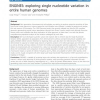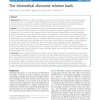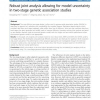BMCBI
2011
13 years 3 months ago
2011
BMCBI
2011
13 years 3 months ago
2011
Background: High-throughput mass spectrometry (MS) proteomics data is increasingly being used to complement traditional structural genome annotation methods. To keep pace with the...
BMCBI
2011
13 years 3 months ago
2011
Background: The identification of drug characteristics is a clinically important task, but it requires much expert knowledge and consumes substantial resources. We have developed ...
BMCBI
2011
13 years 3 months ago
2011
Background: With next-generation sequencing technologies, experiments that were considered prohibitive only a few years ago are now possible. However, while these technologies hav...
BMCBI
2011
13 years 3 months ago
2011
Background: Copy number variants (CNVs), including deletions, amplifications, and other rearrangements, are common in human and cancer genomes. Copy number data from array compara...
BMCBI
2011
13 years 3 months ago
2011
Background: Next generation ultra-sequencing technologies are starting to produce extensive quantities of data from entire human genome or exome sequences, and therefore new softw...
BMCBI
2011
13 years 3 months ago
2011
Background: Identification of discourse relations, such as causal and contrastive relations, between situations mentioned in text is an important task for biomedical text-mining. ...
BMCBI
2011
13 years 3 months ago
2011
Background: The implementation of high throughput sequencing for exploring biodiversity poses high demands on bioinformatics applications for automated data processing. Here we in...
BMCBI
2011
13 years 3 months ago
2011
Background: The cost efficient two-stage design is often used in genome-wide association studies (GWASs) in searching for genetic loci underlying the susceptibility for complex di...
BMCBI
2011
13 years 3 months ago
2011
Background: The search for cluster structure in microarray datasets is a base problem for the so-called “-omic sciences”. A difficult problem in clustering is how to handle da...



